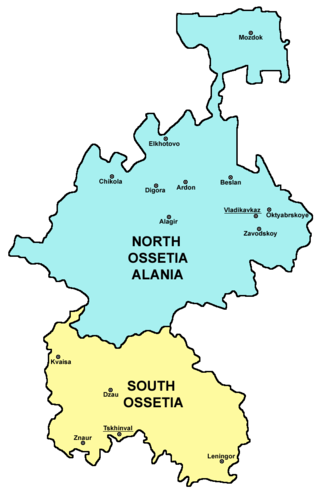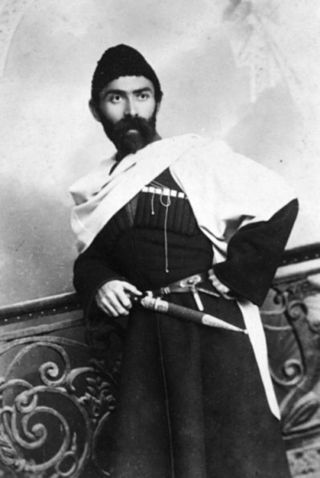Related Research Articles

North Ossetia, officially the Republic of North Ossetia–Alania, is a republic of Russia situated in the North Caucasus of Eastern Europe. It borders the country of Georgia to the south, and the Russian federal subjects of Kabardino-Balkaria to the west, Stavropol Krai to the north, Chechnya to the east and Ingushetia to the southeast. Its population according to the 2021 Census was 687,357. The republic’s capital city is Vladikavkaz, located on the foothills of the Caucasus Mountains.

Ossetia is an ethnolinguistic region located on both sides of the Greater Caucasus Mountains, largely inhabited by the Ossetians. The Ossetian language is part of the Eastern Iranian branch of the family of Indo-European languages. Most countries recognize the Ossetian-speaking area south of the main Caucasus ridge as lying within the borders of Georgia, but it has come under the control of the de facto government of the Russian-backed Republic of South Ossetia – the State of Alania. The northern portion of the region consists of the, Republic of North Ossetia-Alania within the Russian Federation.

Vladikavkaz, formerly known as Ordzhonikidze (Орджоники́дзе) or Dzaudzhikau (Дзауджикау), is the capital city of North Ossetia-Alania, Russia. It is located in the southeast of the republic at the foothills of the Caucasus, situated on the Terek River. The city's population was 295,830 as of the 2021 Census. As a result, Vladikavkaz is one of the most populous cities in the North Caucasus region.

The Ossetians, also known as Ossetes, Ossets, and Alans, are an Iranian ethnic group who are indigenous to Ossetia, a region situated across the northern and southern sides of the Caucasus Mountains. They natively speak Ossetic, an Eastern Iranian language of the Indo-European language family, with most also being fluent in Russian as a second language.

The Republic of North Ossetia – Alania is a federal subject of Russia, located in the Caucasus region.
Ossetia is a region located on both sides of the Greater Caucasus Mountains. The folk music of Ossetia began to be collected and recorded in the late 19th and early 20th century. After the Revolution of 1917, professional music appeared in Ossetia and in the following decades, a number of symphonies, ballets, operas and other institutions were formed. There is an Ossetian State Philharmonic. The first Ossetian opera was Kosta, by Christopher Pliev.
Ossetianliterature is expressed in the Ossetian language, an Iranian language of the Caucasus.
The Dvals were a ethnographic group of Georgians. Their lands lying on both sides of the central Greater Caucasus mountains, somewhere between the Darial and Mamison gorges. This historic territory mostly covers the north of Kartli, parts of the Racha and Khevi regions in Georgia and south of Ossetia in Russia.

Kosta Levanovich Khetagurov was a national poet of the Ossetian people who is generally regarded as the founder of Ossetian literature. He was also a talented painter and a notable public benefactor.

Ottoman cuisine is the cuisine of the Ottoman Empire and its continuation in the cuisines of Greece, Turkey, the Balkans, Caucasus, Middle East and Northern Africa.

Ossetian, commonly referred to as Ossetic and rarely as Ossete, is an Eastern Iranian language that is spoken predominantly in Ossetia, a region situated on both sides of the Russian-Georgian border in the Greater Caucasus region. It is the native language of the Ossetian people, and a relative and possibly a descendant of the extinct Scythian, Sarmatian, and Alanic languages.

Ossetian cuisine refers to the cooking styles and dishes of the Ossetians of the North Caucasus.

Singju is a dish from Manipur. It originated with the Meitei-culture but has been widely adopted by most of the ethnic communities of the state and in some neighbouring states of Northeast India. Often served as a spicy side dish, it is also popular as an afternoon or evening snack.

North Ossetian State University after K.L. Khetagurov is a university in Vladikavkaz, Russia. It was founded in 1920 and was named after Kosta Levanovich Khetagurov. The university is directed at education, cooperation, and innovation.

South Ossetia, a partially-recognized de facto state in the Caucasus and internationally considered part of Georgia, is primarily Eastern Orthodox Christian. A significant minority are adherents of the Ossetian traditional religion, Uatsdin, which is polytheistic and has origins in ancient Scythian religion. Syncretism between Christianity and traditional belief is common.

Assianism is a polytheistic, ethnic and folk religion derived from the traditional narratives of the Ossetians, modern descendants of the Alans of the Scythian tribes, believed to be a continuation of the ancient Scythian religion. It started to be properly reorganized in a conscious way during the 1980s, as an ethnic religion among the Ossetians.
Fælværa or Falvara in Ossetian mythology is the protector of sheep and cattle. He is identified with the deity of hunting Æfsati and has a rivalry with the deity of wolves, Tutyr.
Alardy is a spirit or god of the Ossetian mythology, who inflicts smallpox and measles on children.

Ossetian nationalism is ethnic nationalist ideology promoting Ossetian national identity, the Ossetian language and culture.
References
- ↑ Morgoeva, L. (2015). Паремии и речевые формулы осетинского языка: семантический, прагматический и этнолингвистический аспекты (in Russian). Владикавказ.
{{cite book}}: CS1 maint: location missing publisher (link) - ↑ Takazov, F. (2009). Генезис религиозных воззрений народов Северного Кавказа (in Russian). Vladikavkaz: ИПО СОИГСИ.
- ↑ Дзаттиаты, Р. Г. (2018). Избранное. Археология, этнография, история Осетии (in Russian). Vladikavkaz: СОИГСИ ВНЦ РАН.
- ↑ Kanukova, Z. (2018). Традиция в современном обществе (in Russian). Vladikavkaz.
{{cite book}}: CS1 maint: location missing publisher (link) - ↑ Abaeva, F. (2013). Обрядовый свадебный текст осетин (лексика, семантика, символика) (in Russian). Vladikavkaz.
{{cite book}}: CS1 maint: location missing publisher (link) - ↑ Dzlieva, D. (2014). Динамика исторического развития свадебного музыкального фольклора осетин (in Russian) (Серия "Первая монография" ed.). Vladikavkaz: ИПЦ СОИГСИ ВНЦ РАН and РСО-А.
- ↑ Tuaeva, B. (2016). Северный Кавказ: урбанизационные процессы и культура города. Сборник материалов и документов (in Russian). Germany: LAB.
- ↑ ДЗЕРАНОВ, Т.Е. (15 September 2017). "КАЛОЕВ Б.А. И ЕГО ИССЛЕДОВАНИЯ ТРАДИЦИОННОЙ КУЛЬТУРЫ ОСЕТИН". Известия СОИГСИ. 25 (64). doi: 10.23671/vnc.2017.64.9732 . ISSN 2223-165X.
This article needs additional or more specific categories .(April 2023) |